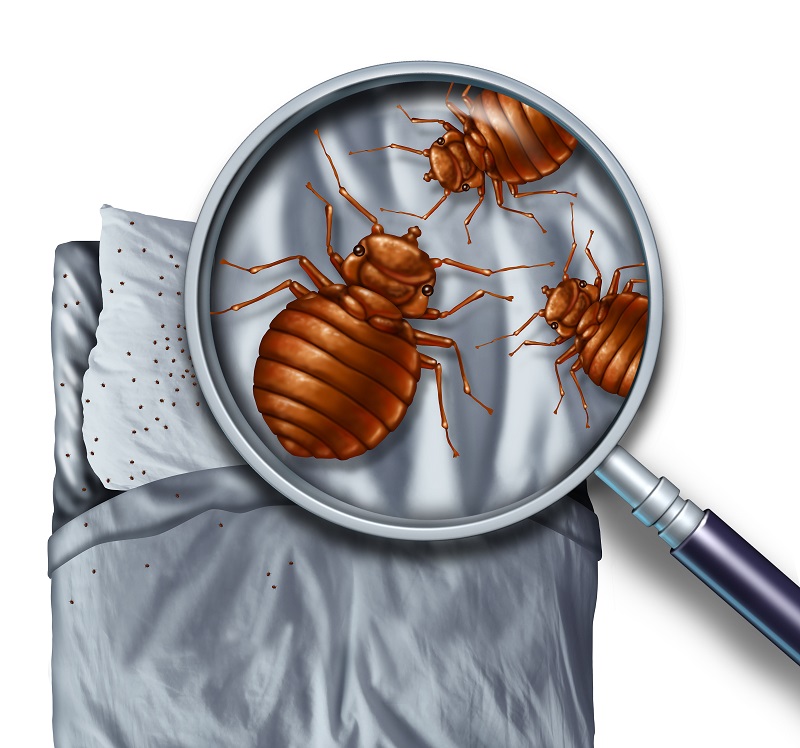(Originally published November 24, 2020; updated November 22, 2022)
Bed bugs in Kansas City were thought to be mostly a myth until somewhat recently. They have recently experienced a resurgence, however, and have become a nuisance for Kansas City hotels, college dorms, hospitals, nursing homes, homes, and apartments.
Bed bugs have been found in every class of hotel from the most run down to the most luxurious. They have even been found on public transportation, such as buses, commuter trains, and airplanes.
The rise in cases is probably the result of several factors including more frequent travel, lack of education about bed bugs and prevention of infestation, and resistance to common pesticide products, among other things.

A Bloody Nuisance
Adult bed bugs are very small, about the size of a tick. In fact, they are often mistaken for ticks or small cockroaches, so we do not always get a call for an infestation as soon as we might like. It is important to call Everett Milberger right away if you suspect bed bugs in Kansas City so that treatment can begin immediately. A free bed bug inspection is available!
Their flattened bodies make it possible for bed bugs to fit into tiny spaces, about the width of a credit card. They do not have nests like ants or bees but tend to live in groups in hiding places.
They hide in the seams and folds of luggage, bags, and clothes, behind wallpaper, and inside bedding and furniture. Their favorite hiding places are typically in mattresses, box springs, bed frames, and headboards where they have easy access to people to bite in the night.
Bed bugs do not fly, but they can move quickly over floors, walls, and ceilings. The bugs may enter your home undetected through luggage, clothing, used beds and couches, and other items. They can crawl more than 100 feet in a night.
Bed bugs are quite prolific and can multiply rapidly. Female bed bugs may lay hundreds of eggs, each of which is about the size of a speck of dust, over a lifetime. Immature bed bugs, called nymphs, shed their skins five times before reaching maturity and require a meal of blood before each shedding. Under favorable conditions, the bugs can develop fully in as little as a month and produce three or more generations per year.
So far, there have been no disease transmission concerns associated with the blood-feeding nature of the bed bug. Some people have reactions to the saliva of the bite of the bed bug though, not unlike a bee sting or spider bite reaction. This can make good sleep extremely difficult, if not impossible.
Common Unwelcome Guests
Studies show that 1 in every 5 households reports bed bug infestations every year. 21% of all bed bug infestations reported in the United States each year are here in the Midwest, second only to the Southeast at 29%.
In a 2018 survey, the three most common environments where pest professionals reported finding bed bugs were single-family homes (91%), apartments/condominiums (89%), and hotels/motels (68%). Past bed bug statistics have shown these places to consistently be the most common places bed bugs have been encountered.
Signs Of Bed Bugs In Kansas City
Bed bugs are small, oval, brownish insects that live on the blood of animals or humans. The adults have flat bodies about the size of an apple seed. After feeding, however, their bodies swell and are a reddish color.
If you suspect an infestation in your home, remove all bedding and check it carefully for signs of the bugs or their excrement. Remove the dust cover over the bottom of the box springs and examine the seams in the wood framing. Peel back the fabric where it is stapled to the wood frame and check there as well.
Check the area around the bed, including inside books, telephones or radios, the edge of the carpet, and even in electrical outlets. Check your closet, because the bugs can attach to clothing.
Signs to look for may include:
- Exoskeletons left after molting.
- bed bugs in the fold of mattresses and sheets.
- Rust-colored blood spots left by the blood-filled fecal material that they excrete on the mattress or nearby furniture.
- A sweet, musty odor.
5 Tips To Avoid Infestation
1) Inspect furniture and other items before you bring them home.
Thoroughly inspect used furniture, especially in seams and between cushions, for signs of bed bugs before bringing it into your home. Look for reddish or rusty stains on light colored pieces caused by bed bugs being crushed or dark spots of excrement that bleed like a marker. You should also look for live bed bugs and their eggs and shells, which are only about 1mm and have pale yellow skins that the nymphs shed as they grow.
2) Use care when traveling.
A few minutes spent checking your room when away from home can prevent a lot of pain and annoyance.
Unfortunately, these bugs are tiny – usually 4mm to 5mm at most – so they’re easy to miss. They are about the size and shape of an apple seed. You don’t have to see the actual bug to recognize an infestation, though.
Here’s what to do as soon as you get into your hotel room:
- Put your suitcase or backpack in the bathroom. If you can prop it on the tub or counter instead of on the floor, even better. Do the best you can to keep your luggage off the bed and off the floor, especially carpets.
- Look very closely at the sheets for tiny stains, eggs, and skins that have been shed. You should pull back the blankets and look at the entire length of the sheets as well as the blankets themselves.
- Take the sheets off the bed and inspect the mattress. Use a credit card or something similar to check out the crevices and seams where the tiny bugs are likely to hide.
- If possible, flip the mattress to check the other side, and inspect the box spring, bed frame, and headboard.
If you suspect bed bugs, ask for another room or even consider switching hotels. Just because one room is infested doesn’t mean the entire hotel is, but it’s also common for the bugs to move from one room to another.
These bugs are avid hitchhikers and can travel back to Kansas City in your luggage, so it is advisable to take a few precautions.
- Clothing should be washed and run through the dryer on high heat when you return home.
- If you use shared laundry facilities, you should carry your laundry in a plastic bag.
- Remove laundry from the dryer directly into a new plastic bag if you suspect an infestation, and fold your clothes at home.
- Luggage should be sealed into a plastic bag for several months to a year, as bed bugs can survive that long without feeding under some conditions.
3) Make your bed inhospitable to bed bugs in Kansas City.
Wash your bedding regularly and dry it on the highest heat setting. Use a high-quality, tear-resistant protective cover that encloses your mattress and box springs to eliminate many of their hiding spots. The cover’s light coloring makes the bugs easier to see, and you should inspect it frequently for holes as well as signs of bed bugs. You can also purchase a cover that is pre-treated with pesticides to control bed bugs.
4) Keep your home clean and uncluttered.
Bed bugs’ movement is not limited to the bed itself, so vacuuming the floors can help eliminate them before they get out of control. The more cluttered an area, the more places for bed bugs to hide.
Eliminate all clutter against bedroom walls, as this is an attractive hiding place. Organize and properly store your belongings to avoid any type of infestation. According to the CDC, the best way to prevent bed bugs is regular inspection for signs of an infestation.
5) Hire a professional that knows bed bugs in Kansas City.
If you discover bed bugs in your home, don’t just start spraying poison and hope for the best. The unfortunate truth is that DIY methods are simply not effective. Bed bugs are one of the most difficult pests to get rid of but it isn’t impossible.
Don’t panic and start throwing everything away, either! (In fact, throwing things out would just spread the problem to another home.) Bed bugs are nearly impossible to remove on your own, but the experts at Everett Milberger Pest Control are here to help.
Integrated Pest Management
Traditional approaches to controlling bed bugs that rely on the use of pesticides alone are no longer effective because bed bugs have developed resistance to them. The best to handle a bed bug infestation is to use a multi-faceted approach.
Integrated Pest Management, or IPM, is a multi-faceted approach to dealing with many types of pest problems. IPM has been used mostly for agricultural pests in the past, but it is the most effective method for dealing with household pests such as bed bugs.
The primary components of an IPM plan for bed bugs include accurate identification, a thorough understanding of bed bug biology and behavior, the use of multiple control techniques (both pesticide and pesticide-free), and periodic re-evaluation of the infested area to ensure that the pests do not return.
Bed Bugs In Kansas City Are No Match For Everett Milberger
The Missouri Department of Health and Senior Services recommends hiring a licensed pest control professional to identify and exterminate a pest infestation like bed bugs safely and appropriately. Milberger technicians are specially trained to thoroughly inspect your home or business to find all the places bed bugs may be hiding and determine how best to eradicate them, then provide you with a quote at no cost or obligation to you.
If you are concerned about bed bugs in your Kansas City home or business, call (816) 761-1313 in Missouri or (913) 384-6760 in Kansas, or click here to schedule your free inspection today!
